This post is part of an ongoing series on the credit and liquidity facilities established by the Federal Reserve to support households and businesses during the COVID-19 outbreak.
Over the first three weeks of March, as uncertainty surrounding the COVID-19 pandemic increased, prime and municipal (muni) money market funds (MMFs) faced large redemption pressures. Similarly to past episodes of industry dislocation, such as the 2008 financial crisis and the 2011 European bank crisis, outflows from prime and muni MMFs were mirrored by large inflows into government MMFs, which have historically been seen by investors as a safe haven in times of crisis. In this post, we describe a liquidity facility established by the Federal Reserve in response to these outflows.
The Fed Intervention and Its Goals
From March 2 to March 23, the assets under management (AUM) of prime and muni MMFs dropped by $120 billion (15 percent of the industry) and $9 billion (7 percent of the industry). To prevent outflows from prime and muni MMFs from turning into an industry-wide run, as happened in September 2008 when one prime MMF “broke the buck,” the Federal Reserve announced the establishment of the Money Market Mutual Fund Liquidity Facility, or MMLF, on March 18. Under this facility, the Federal Reserve Bank of Boston provides loans to eligible borrowers (U.S. depository institutions, bank holding companies, and branches and agencies of foreign banks), taking as collateral eligible securities purchased from prime and muni MMFs. The U.S. Department of the Treasury provides $10 billion of credit protection to the Federal Reserve from the Treasury’s Exchange Stabilization Fund.
The set of eligible collateral was gradually expanded over time; it now includes U.S. Treasuries, government-sponsored enterprise (GSE) debt, first-tier asset-backed and unsecured commercial paper (CP), top-tier negotiable certificates of deposit (CDs), municipal short-term debt, and variable rate demand notes (VRDNs). All securities accepted under the facility must have a residual maturity lower than twelve months or, in the case of VRDNs, must be putable within 12 months. The facility officially opened on March 23, and usage has been robust, with outstanding loans of more than $50 billion as of April 14.
The facility, which has many similarities with the Asset-Backed Commercial Paper Money Market Mutual Fund Liquidity Facility (AMLF) put in place during the 2008 financial crisis, can be beneficial in two ways. First, by facilitating the sales of securities, it helps MMFs meet redemptions in an environment in which secondary market liquidity is strained. Second, by reassuring MMF investors that funds will be able to meet redemptions in the future, it reduces their incentive to withdraw preemptively, thereby reducing overall outflows. As outflows abate, prime and muni MMFs can continue to fund American businesses, states, and other localities.
The Direct Effects
The facility has been very successful, over a short period of time, at slowing investor outflows from prime and muni MMFs and improving conditions in money markets. As the charts below show, since the facility’s inception to the end of March, prime MMFs only suffered a $20 billion decline in AUM, more than half of which occurred over the first two days after the inception (before CDs and VRDNs became eligible collateral on March 25); on April 2, prime MMFs started to experience moderate inflows.
Similarly, outflows from muni MMFs stopped on March 25, when VRDNs (an important part of their portfolios) became eligible collateral; muni-MMF AUM have been increasing since and are now back at their level at the beginning of the year.
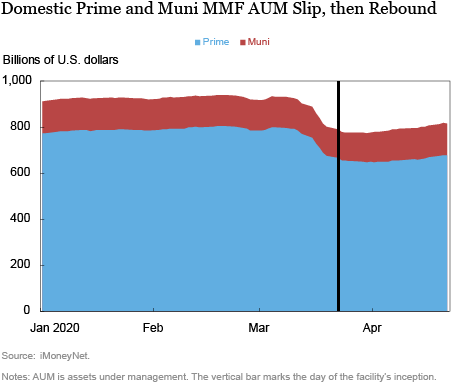
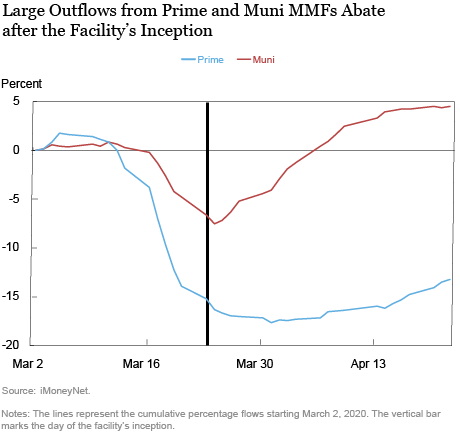
By helping prime and muni MMFs meet redemptions without having to sell in disorderly markets, the MMLF has also supported the net asset value (NAV) of prime and muni MMFs. As the chart below shows, in the second half of March, for the bottom 10th percentile of prime and muni MMFs, the NAV per share dropped below $1 by more than 10 basis points (a large drop for the MMF industry) only to recover after the facility was put in place. In addition, the NAV of the median fund also dropped below $1, went back to $1 by early April, and has been above that level since. Similarly, by converting less liquid collateral (such as CP and CDs) into cash, the facility has also allowed prime and muni MMFs to rebuild their buffers of liquid assets, which had been partly depleted over the high redemption period.

Finally, although the effect of the facility cannot be easily disentangled from other interventions of the Federal Reserve, conditions in money markets also improved shortly after the introduction of the MMLF. For instance, as the next chart shows, rates on 30‐day AA asset‐backed CP, which peaked at 2.37 percent on March 23, traded at 0.54 percent on April 17.
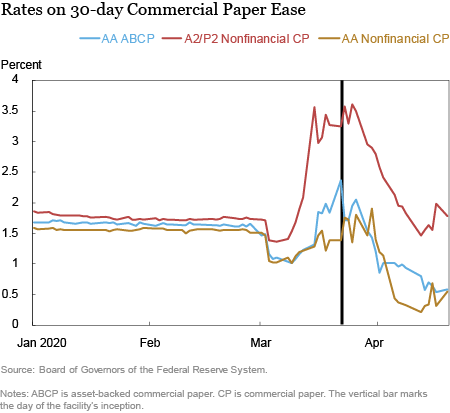
The Indirect Effects
Offshore USD MMFs are funds domiciled abroad that, similarly to domestic MMFs, invest in dollar-denominated money-market instruments with short maturity and high credit quality; also similarly to domestic funds, they can be broadly classified into government and prime funds, depending on whether they hold mainly public or private debt. They mainly cater to institutional investors.
As the charts below show, from March 4 to March 23, offshore USD prime MMFs lost $90 billion of their AUM (23 percent of the industry size), whereas offshore government MMFs witnessed inflows of about $54 billion, similar to their domestic counterparts. By easing broad money-market conditions, the MMLF also had a positive effect on offshore USD prime MMFs. After the MMLF came into place, outflows from offshore prime MMFs slowed significantly, and since April 1, their AUM have increased constantly throughout April 17.
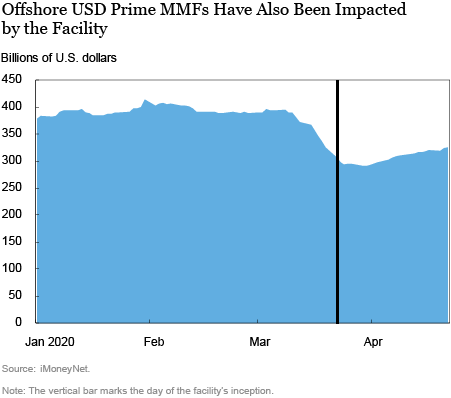
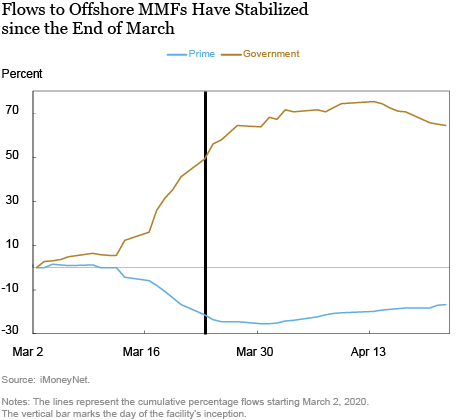
Another indirect effect of the facility was to stem the inflows into government MMFs. As mentioned above, government funds received large inflows during the last two weeks of March. Such inflows led to increased usage of the overnight reverse repurchase agreement facility (ONRRP) as government MMFs sought investment opportunities for the large inflows they were receiving. Moreover, if they had continued, these inflows may have put pressure on funds’ NAV, especially in an environment with very low interest rates. As the charts below show, after the establishment of the MMLF, as investors became more confident about the outlook of the prime MMF sector, inflows into government funds receded.
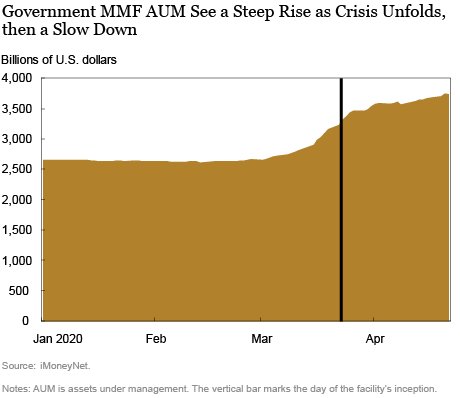
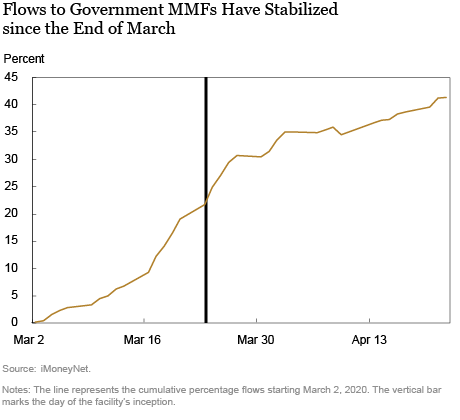
Conclusions
The MMLF helped reduce outflows from prime and municipal MMFs. The facility not only helped avoid a broad run on the MMF industry but also eased the strains in money markets that had emerged since the second week of March. Because of its positive effect on secondary markets, the facility has also had a beneficial impact on offshore MMFs, which it does not directly target. By helping prime and muni MMFs meet demands for redemptions and by reducing outflows from the industry, the facility not only improves overall market functioning but also supports the provision of credit to the real economy.

Marco Cipriani is an assistant vice president in the Federal Reserve Bank of New York’s Research and Statistics Group.

Gabriele La Spada is a senior economist in the Bank’s Research and Statistics Group.

Reed Orchinik is a senior research analyst in the Bank’s Research and Statistics Group.

Aaron Plesset is a senior research analyst in the Bank’s Research and Statistics Group.
Also in the Liberty Street Economics Facilities Series
Helping State and Local Governments Stay Liquid, April 10
The Commercial Paper Funding Facility, May 15
The Primary Dealer Credit Facility, May 19
The Paycheck Protection Program Liquidity Facility (PPPLF), May 20
The Primary and Secondary Market Corporate Credit Facilities, May 26
Securing Secured Finance: The Term Asset-Backed Securities Loan Facility, August 7
Up on Main Street, February 5
How to cite this post:
Marco Cipriani, Gabriele La Spada, Reed Orchinik, and Aaron Plesset, “The Money Market Mutual Fund Liquidity Facility,” Federal Reserve Bank of New York Liberty Street Economics, May 8, 2020, https://libertystreeteconomics.newyorkfed.org/2020/05/the-money-market-mutual-fund-liquidity-facility.html.
Disclaimer
The views expressed in this post are those of the authors and do not necessarily reflect the position of the Federal Reserve Bank of New York or the Federal Reserve System. Any errors or omissions are the responsibility of the authors.










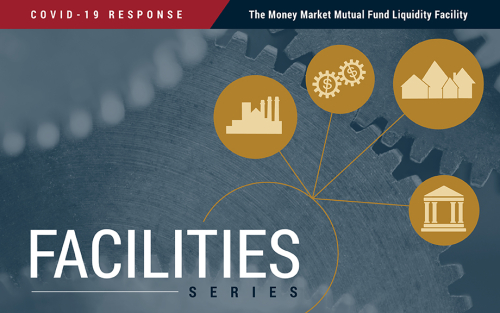
 RSS Feed
RSS Feed Follow Liberty Street Economics
Follow Liberty Street Economics